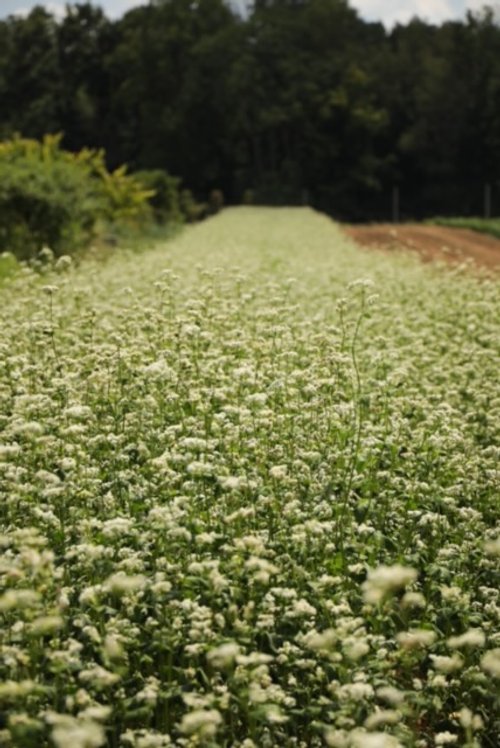Growing Healthier Soils Through Cover Cropping
BY JEFF SWANN
Photo by Anthony Villa
Cover crops are something that you grow on purpose in your garden or farm plots during times when you don't have your regular annual vegetables or flowers growing. It is common to plant tomatoes or squash in May and you expect them to die off sometime in late summer. If you spend an afternoon in the fall doing garden clean-up, the final step is to sow something in the plot to provide a living cover until the next season. The cover will protect your soil from winds and heavy rain, keep the soil from washing away, and the cover plants will collect nutrients that are available in the soils left over from your spring or summer compost application. The root exudates of the living plants and later their decomposing bodies also provide a consistent food supply for the soil organisms you want to foster. Just like we want our human communities to be robust, diverse, resilient, and full of connections - we want the same thing for the communities of fungi, bacteria, invertebrates and vertebrates in our soils.
Weeds do a passable job of cover cropping, often providing some nectar and habitat for insects, putting carbon in the soil with their roots, and are well suited to the space and conditions. The mix of weeds that dominate also can give clues to soil structure and which nutrients are either heavy or light. Early spring weeds like chickweed and deadnettle make fine cover crops in front of summer planted vegetables. Even the despised buttercups are holding the soil and trying to improve the structure. The biggest downside is that if you have a mix of weeds they'll make seeds at all different times plus weeds can host pests and diseases that bother cultivated plants. The other problem is termination... My vexatious buttercup stand requires a lot of fairly violent tillage to knock it down. I know that if I have to till, chisel, disc or cultivate too many times to kill it, I'm losing most of the benefits it brought because the tillage introduces so much oxygen into the top layer of soils and causes the organic matter the plants collected to oxidize and be lost prematurely.
If you are trying to minimize tillage, terminating fall sown cover crops that come on strong in spring (like rye and wheat) can be very challenging. I've found over several years that using winter killed covers solves that problem. It also addresses the downsides caused by the weed cover crop. The basic principle is you select fall covers specifically so they'll be killed over winter by a series of hard freezes, then very slowly decay over the course of the rest of the winter and early spring. This way you don't have to destroy the soil structure you've tried to foster over the winter months to prep the ground for the following crop, and you don't have so much crop residue that it harbors slugs, keeps the ground from warming, or makes direct seeding impossible.
Generations of gardeners in this region have used turnips for fall cover crops in their gardens, and of course they also got a bonus of unlimited messes of nutritious turnip greens through most of the winter. The turnips mostly winter kill, and their decaying roots leave behind great soil structure. If your family gets tired of turnip greens, you can mix in mustard, collards and kale and get the same effect. My great granny Swann had three sons. One loved turnip greens, one loved collards, and one loved mustard so she always sowed all three.
Turnip root masses always have worms intertwined and a bunch of hairs that I suspect are some kind of beneficial fungi mycelium. A variation of using the old time turnip cover crop is the daikon radish, or tillage radish. This is something that East Asian farmers have been doing for millennia, but it is not traditional in the Southeast U.S. If you time it just perfectly, soil fertility is adequate, and you get enough moisture, you can grow giant daikons that crack the plow pan, then freeze and decay away to fibers that extend into the ground 12 inches or more by March. A good stand also seems to be allelopathic to other weeds, as I've had seasons where the daikon patch was rotted down, had 1-2" holes going vertically into the soil for air and water penetration, and could be made ready to plant with one light cultivator pass. Brassica cover plots are great to use in advance of potatoes, onions, peas, carrots and the like.
Unfortunately, since turnips and other crops mentioned above are in the same family as cabbage, broccoli, cauliflower, and radishes it can be a risk to sow any of those crops in the spring since there are bacterial, viral, and fungal diseases that can set up in your soils and attack the turnip cousins. Some of them can be nasty and hang around for a long time. If you are trying to grow organically and are not inclined to use fungicides, the set of tools for managing soil born illnesses can be limited. Not planting crops of the same family successively in the same spot is one of the most powerful tools there is.
If you want to get a plot prepped in time for an early spring planting of cabbages, broccoli, and radishes but don't want to risk fall brassicas spreading disease, spring oats are a great choice. If you go to the feed store and buy jerry oats, or even just a bag of whole feed oats and broadcast and harrow or drill in September, they'll come right up as soon as soil moisture permits. As winter comes on and days get shorter they'll slow down, and with successive freezes get weaker and weaker. Usually they’ll be dead by February. The tops will protect soil surface from crusting and the roots will hold the soil against wind and washing - but the three to four months of growth you get are almost free organic matter. Once the days start getting warmer but the soil is not too wet, you can run over them with a disc and lightly incorporate and they'll rot down pretty well if your soils are active biologically. They'll incorporate even better if you spread a little compost beforehand.
You can boost the nitrogen by adding winter peas into the mix. This will keep the oat residue from tying up too much nitrogen as it decomposes. Sometimes I buy up whatever spring peas they have to get rid of at the feed store at the end of the season, sometimes putting down Austrian winter peas. Either one works. They can live a little better in the cold than the oats, but they are easy to kill mechanically if they do survive winter. You can scythe them down in a garden bed or just disc down in a field. Since oats and peas are a totally different family of plants than all the other spring vegetables, planting these as cover crops can help you avoid disease pressure. Garden peas should not follow winter peas for the same reason cabbage should not follow turnips, so bear that in mind. Remember: you must use a spring oat variety (not a fall oat!).
Besides winter peas, I've never figured out a good nitrogen fixing cover to precede an early spring garden. Crimson clover is great to grow with oats, but it needs to grow longer in spring to really give a good nitrogen boost and work its magic. If you kill it in March it never really gets a chance. Oats and crimson clover are a fantastic choice in advance of a late May or June planting though. Most of the other clovers need even longer to do their job and most of the gardeners I know are not willing or able to leave a patch in clover for a 12-18 months. It would be wise to consider though if you have the space and time.
I've always considered cover crop seed to be part of my fertility budget. Cover crop seed can be expensive, but it costs a fraction of what conventional fertilizers do, and there are no environmental downsides. While conventional fertilizers have a high carbon footprint in their manufacture and transport and can easily run off into watersheds and leach into groundwater, cover crops capture fertility from the sun, air, and soils and lock it into the plants themselves. If you choose your plants and times wisely, you can also deter undesirable volunteers. It is a gift from natural processes that you can gently bend to your benefit.
I try to keep something growing on my plots all the time, that way I've always got some kind of plant working for me, collecting solar energy and carbon, and creating food and habitat for soil biota, which helps make the plot and soils stronger and more resilient.
About the Author:
Jeff Swann is the owner and operator of Swann Farms, located in White County, TN. Swann Farms uses organic and regenerative practices to build soil, sequester carbon, and grow food for the local community. With an emphasis on grains and meat, Swann Farms practices cover cropping, green manuring, crop rotation, and rotational grazing with heritage breeds of cattle, sheep, and hogs.

